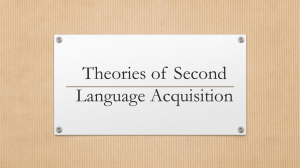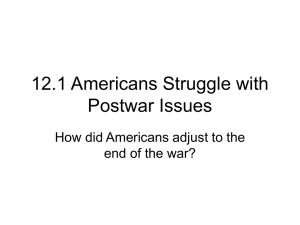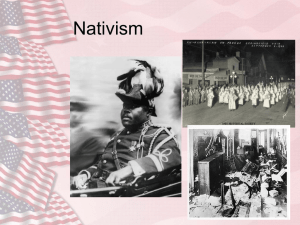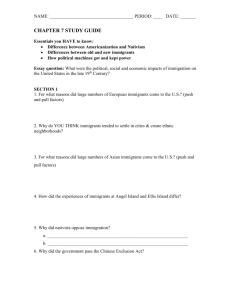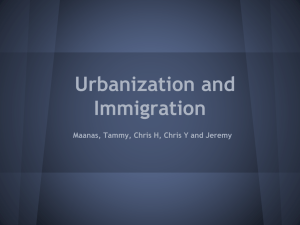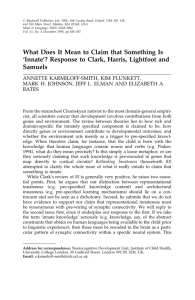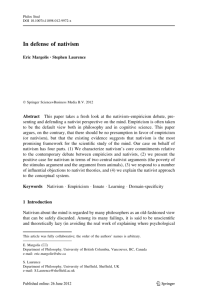Nativism - Political Research Associates
advertisement
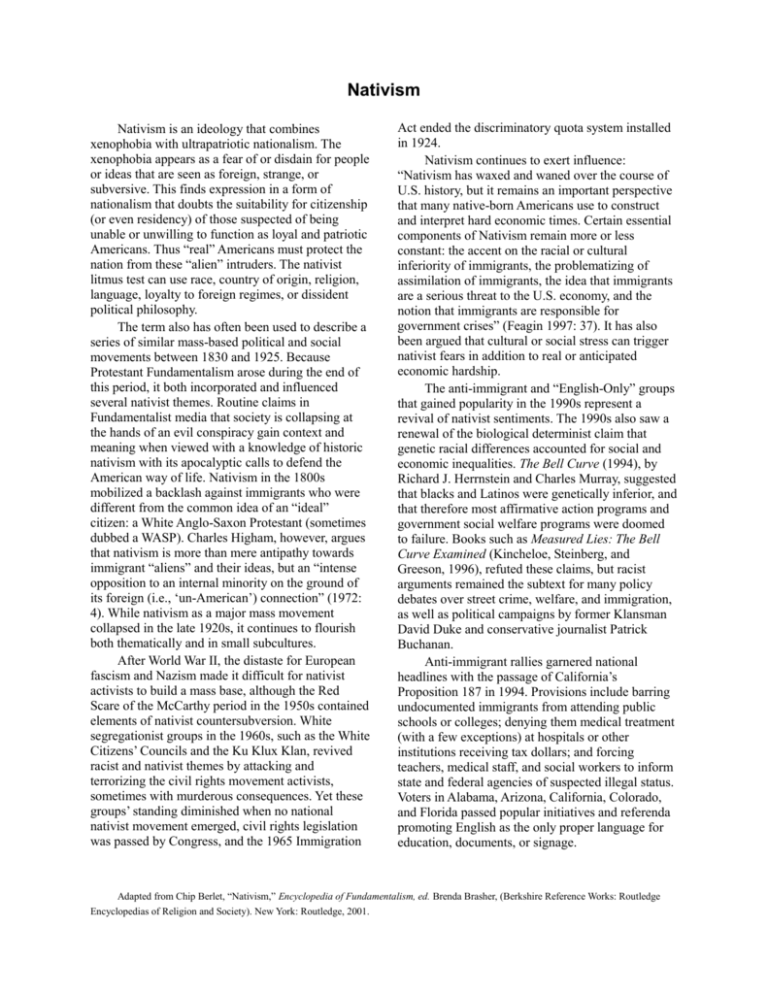
Nativism Nativism is an ideology that combines xenophobia with ultrapatriotic nationalism. The xenophobia appears as a fear of or disdain for people or ideas that are seen as foreign, strange, or subversive. This finds expression in a form of nationalism that doubts the suitability for citizenship (or even residency) of those suspected of being unable or unwilling to function as loyal and patriotic Americans. Thus “real” Americans must protect the nation from these “alien” intruders. The nativist litmus test can use race, country of origin, religion, language, loyalty to foreign regimes, or dissident political philosophy. The term also has often been used to describe a series of similar mass-based political and social movements between 1830 and 1925. Because Protestant Fundamentalism arose during the end of this period, it both incorporated and influenced several nativist themes. Routine claims in Fundamentalist media that society is collapsing at the hands of an evil conspiracy gain context and meaning when viewed with a knowledge of historic nativism with its apocalyptic calls to defend the American way of life. Nativism in the 1800s mobilized a backlash against immigrants who were different from the common idea of an “ideal” citizen: a White Anglo-Saxon Protestant (sometimes dubbed a WASP). Charles Higham, however, argues that nativism is more than mere antipathy towards immigrant “aliens” and their ideas, but an “intense opposition to an internal minority on the ground of its foreign (i.e., ‘un-American’) connection” (1972: 4). While nativism as a major mass movement collapsed in the late 1920s, it continues to flourish both thematically and in small subcultures. After World War II, the distaste for European fascism and Nazism made it difficult for nativist activists to build a mass base, although the Red Scare of the McCarthy period in the 1950s contained elements of nativist countersubversion. White segregationist groups in the 1960s, such as the White Citizens’ Councils and the Ku Klux Klan, revived racist and nativist themes by attacking and terrorizing the civil rights movement activists, sometimes with murderous consequences. Yet these groups’ standing diminished when no national nativist movement emerged, civil rights legislation was passed by Congress, and the 1965 Immigration Act ended the discriminatory quota system installed in 1924. Nativism continues to exert influence: “Nativism has waxed and waned over the course of U.S. history, but it remains an important perspective that many native-born Americans use to construct and interpret hard economic times. Certain essential components of Nativism remain more or less constant: the accent on the racial or cultural inferiority of immigrants, the problematizing of assimilation of immigrants, the idea that immigrants are a serious threat to the U.S. economy, and the notion that immigrants are responsible for government crises” (Feagin 1997: 37). It has also been argued that cultural or social stress can trigger nativist fears in addition to real or anticipated economic hardship. The anti-immigrant and “English-Only” groups that gained popularity in the 1990s represent a revival of nativist sentiments. The 1990s also saw a renewal of the biological determinist claim that genetic racial differences accounted for social and economic inequalities. The Bell Curve (1994), by Richard J. Herrnstein and Charles Murray, suggested that blacks and Latinos were genetically inferior, and that therefore most affirmative action programs and government social welfare programs were doomed to failure. Books such as Measured Lies: The Bell Curve Examined (Kincheloe, Steinberg, and Greeson, 1996), refuted these claims, but racist arguments remained the subtext for many policy debates over street crime, welfare, and immigration, as well as political campaigns by former Klansman David Duke and conservative journalist Patrick Buchanan. Anti-immigrant rallies garnered national headlines with the passage of California’s Proposition 187 in 1994. Provisions include barring undocumented immigrants from attending public schools or colleges; denying them medical treatment (with a few exceptions) at hospitals or other institutions receiving tax dollars; and forcing teachers, medical staff, and social workers to inform state and federal agencies of suspected illegal status. Voters in Alabama, Arizona, California, Colorado, and Florida passed popular initiatives and referenda promoting English as the only proper language for education, documents, or signage. Adapted from Chip Berlet, “Nativism,” Encyclopedia of Fundamentalism, ed. Brenda Brasher, (Berkshire Reference Works: Routledge Encyclopedias of Religion and Society). New York: Routledge, 2001. Bibliography History of Nativism Bennett, David H. ([1988] 1995). The Party of Fear: The American Far Right from Nativism to the Militia Movement, rev. ed. New York: Vintage Books. Berlet, Chip, and Matthew N. Lyons. (2000). Right-Wing Populism in America: Too Close for Comfort. New York: Guilford Press. Billington, Ray Allen. ([1933] 1974). The Origins of Nativism in the United States 1800–1844. New York: Arno Press. Davis, David Brion, ed. (1971). The Fear of Conspiracy: Images of Un-American Subversion from the Revolution to the Present. Ithaca, NY: Cornell University Press. Diamond, Sara. (1995). Roads to Dominion: Right-Wing Movements and Political Power in the United States. New York: Guilford Press. Feagin, Joe R. (1997). “Old Poison in New Bottles: The Deep Roots of Modern Nativism.” In Immigrants Out! The New Nativism and the Anti-Immigrant Impulse in the United States, edited by Juan F. Perea. New York: New York University Press, 13–43. Higham, John. ([1955] 1972). Strangers in the Land: Patterns of American Nativism 1860–1925. New York: Atheneum. Hofstadter, Richard. (1965). The Paranoid Style in American Politics and Other Essays. New York: Alfred A. Knopf. Knoebel, Dale T. (1996). America for the Americans: The Nativist Movement in the United States. New York: Twayne Publishers. Perea, Juan F. (1997). Immigrants Out! The New Nativism and the Anti-Immigrant Impulse in the United States. New York: New York University Press. Ribuffo, Leo P. (1983). The Old Christian Right: The Protestant Hard Right from the Great Depression to the Cold War. Philadelphia: Temple University Press. White Supremacy Bonilla-Silva, Eduardo. (2001). White Supremacy and Racism in the Post-Civil Rights Era. Boulder, Colo: L. Rienner. Bonilla-Silva, Eduardo. (2003). Racism without Racists: Color-Blind Racism and the Persistence of Racial Inequality in the United States. Lanham, Md: Rowman & Littlefield. Doane, Ashley W. and Eduardo Bonilla-Silva. (2003). White Out: the Continuing Significance of Racism. New York: Routledge. Ignatiev, Noel. 1995. How the Irish Became White. New York: Routledge. Kincheloe, Joel L., Shirley R. Steinberg, and Aaron D. Greeson, III, eds. (1996). Measured Lies: The Bell Curve Examined. New York: St. Martin’s Press. Prejudice & Oppression Guillaumin, Colette. (1995). Racism, Sexism, Power and Ideology. London: Routledge. Noël, Lise. (1994). Intolerance: A General Survey. Translated by Arnold Bennett. Montreal: McGill-Queen’s University Press. Young-Bruehl, Elisabeth. (1996). The Anatomy of Prejudices. Cambridge, Mass.: Harvard University Press. Political Research Associates is an independent, nonprofit research center that studies antidemocratic, authoritarian, and other oppressive movements, institutions, and trends. PRA is based on progressive values, and is committed to advancing an open, democratic, and plura listic society. P RA provides accurate, reliable research and analysis to activists, journalists, educators, policy makers, and the public at large. http://www.publiceye.org

